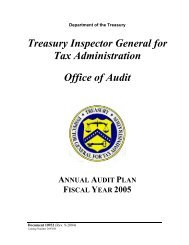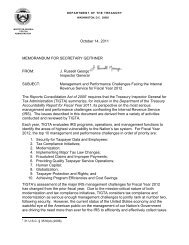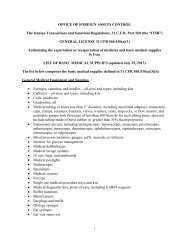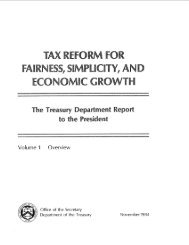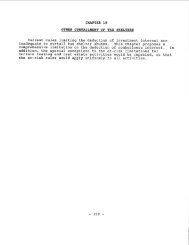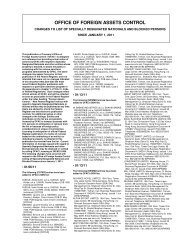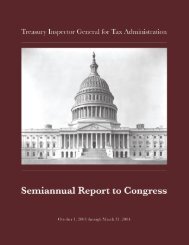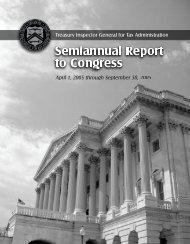status of internal revenue service reform hearing before
status of internal revenue service reform hearing before
status of internal revenue service reform hearing before
Create successful ePaper yourself
Turn your PDF publications into a flip-book with our unique Google optimized e-Paper software.
Testimony 02-02-2000<br />
file://C:\Documents%20and%20Settings\roy\Desktop\gopdf\html\testimony_02022000.htm<br />
Page 1 <strong>of</strong> 7<br />
5/26/2004<br />
STATUS OF INTERNAL REVENUE SERVICE REFORM<br />
HEARING BEFORE THE<br />
COMMITTEE ON FINANCE<br />
UNITED STATES SENATE<br />
FEBRUARY 2, 2000<br />
STATEMENT FOR THE RECORD<br />
DAVID C. WILLIAMS<br />
INSPECTOR GENERAL<br />
TREASURY INSPECTOR GENERAL FOR TAX ADMINISTRATION
Testimony 02-02-2000<br />
file://C:\Documents%20and%20Settings\roy\Desktop\gopdf\html\testimony_02022000.htm<br />
Page 2 <strong>of</strong> 7<br />
5/26/2004<br />
Mr. Chairman and members <strong>of</strong> the committee, I appreciate the opportunity to appear<br />
<strong>before</strong> you today to discuss the progress the Internal Revenue Service (IRS) has<br />
made in the past year and the challenges that lie ahead.<br />
I agree with Commissioner Rossotti’s statement that, "Modernizing the IRS is a<br />
massive undertaking and will take years to complete and depends upon changes in<br />
the organization and technology." The IRS is undertaking a complex, multifaceted<br />
approach to restructure its processes and operations. The changes that are taking<br />
place within the IRS affect almost every aspect <strong>of</strong> its operations. Also, modernization<br />
<strong>of</strong> its computer systems is crucial to implementing the new business vision <strong>of</strong><br />
providing world-class <strong>service</strong> to taxpayers.<br />
Progress is <strong>of</strong>ten occurring at a slow and methodical pace, but some positive results<br />
are being realized. In response to the IRS Restructuring and Reform Act <strong>of</strong> 1998<br />
(RRA 98), the IRS has begun to transform itself so that it will operate better and<br />
<strong>service</strong> its customers more efficiently. It has also begun the process <strong>of</strong> restructuring<br />
the organization into four new operating divisions that serve groups <strong>of</strong> taxpayers with<br />
similar needs. The leaders <strong>of</strong> these units are now in place, and the Tax<br />
Exempt/Government Entities Division is beginning operations.<br />
The IRS is also expanding its operations through the use <strong>of</strong> technology. Electronic<br />
filing programs such as Telefile, E-file, and On-line filing increased substantially last<br />
year, providing taxpayers with the ability to file returns from their home computers.<br />
This type <strong>of</strong> technology produces faster refunds, reduces errors, and reduces costs.<br />
The IRS has also introduced a 24-hour-a-day/7 day-a-week telephone <strong>service</strong>,<br />
expanded its walk-in <strong>service</strong> hours, and provided translators for taxpayers who do not<br />
feel comfortable using English.<br />
The IRS has changed its mission statement to stress its role in helping taxpayers<br />
meet their tax obligations. Full implementation <strong>of</strong> the RRA 98 provisions should result<br />
in enhanced taxpayer protection and rights, as well as organizational changes<br />
intended to achieve a more efficient and responsive organization. As we observe the<br />
progress being made, my <strong>of</strong>fice is focused on certain aspects that bear close<br />
observation or that we believe could inhibit the success <strong>of</strong> current operations or<br />
planned initiatives.<br />
The IRS must continue to address management and operational issues to provide<br />
first-rate customer <strong>service</strong> and ensure compliance with the tax laws. The challenge for<br />
the IRS is to achieve both <strong>of</strong> these goals within the constraints <strong>of</strong> existing resources.<br />
The global economy is also growing rapidly and is generating increasingly<br />
sophisticated and complex business transactions. The IRS must develop effective<br />
compliance programs for this expanding segment <strong>of</strong> taxpayers.<br />
Financial Management<br />
Improvements have been made, but the IRS’ accounting systems do not conform to<br />
federal accounting standards, nor will they for several years. The lack <strong>of</strong> standard<br />
accounting tools imposes ongoing costs, impedes the ability <strong>of</strong> the IRS to serve
Testimony 02-02-2000<br />
file://C:\Documents%20and%20Settings\roy\Desktop\gopdf\html\testimony_02022000.htm<br />
Page 3 <strong>of</strong> 7<br />
5/26/2004<br />
taxpayers adequately and prevents the IRS from effectively addressing material<br />
weaknesses cited by the General Accounting Office (GAO). In addition, the GAO,<br />
which has overall responsibility to audit the IRS’ financial statements, has reported six<br />
material weaknesses involving the following: inadequate financial reporting processes,<br />
supporting subsidiary ledger and documentation for unpaid assessments, controls<br />
over refunds, controls over fund balance with the Department <strong>of</strong> Treasury, controls<br />
over property and equipment, and computer security.<br />
The Government Performance and Results Act <strong>of</strong> 1993<br />
The IRS uses a strategic planning process that describes how goals and objectives<br />
are to be achieved and provides clear links between performance measures and the<br />
funding requests. However, TIGTA’s review found the IRS’ overall strategic plan and<br />
its Fiscal Year 2000 Annual Performance Plan were not in complete compliance with<br />
the Government Performance and Results Act <strong>of</strong> 1993 (GPRA), Office <strong>of</strong> Management<br />
and Budget (OMB), and Department <strong>of</strong> the Treasury guidelines. The IRS’ strategic<br />
plan did not: explain how performance measures and goals relate to each other,<br />
address external factors that impact its mission and goals, and describe program and<br />
system evaluations. TIGTA recommended to the IRS, and they agreed, to designate<br />
an <strong>of</strong>fice responsible for oversight and coordination <strong>of</strong> GPRA requirement activity<br />
throughout the IRS.<br />
Because the IRS is undergoing such a complete transformation <strong>of</strong> its business<br />
processes, its performance measures are being re-evaluated. The IRS is developing a<br />
new balanced performance measurement system that will focus on accomplishments<br />
in three major areas: business results, customer satisfaction, and employee<br />
satisfaction. Commissioner Rossotti has indicated that it will take several years to<br />
achieve a fully acceptable set <strong>of</strong> balanced measures that can be used at all levels <strong>of</strong><br />
the organization.<br />
Management Information Systems<br />
IRS management should be able to rely on computer programs and applications that<br />
provide timely and accurate data for analysis and functional control. Management<br />
information is a critical tool in monitoring progress and identifying vulnerabilities and<br />
production concerns. Not all IRS management information systems provide sufficient<br />
data to ensure taxpayer rights are protected and its financial management systems do<br />
not provide reliable data for the IRS’ financial statements. For example, the IRS did<br />
not have a reliable management information system to measure the Innocent Spouse<br />
Program accomplishments and results. The IRS also did not have a database to<br />
reliably track innocent spouse case closures. As a result, accurate information was not<br />
available on the number <strong>of</strong> innocent spouse cases closed, how they were closed, or<br />
the <strong>status</strong> <strong>of</strong> claims in inventory.<br />
Taxpayer Compliance<br />
Voluntary – IRS statistics indicate that collections from personal income taxes<br />
increased by almost eight percent in 1999, while collections <strong>of</strong> corporate income taxes<br />
decreased by two percent during a dramatic economic upturn.
Testimony 02-02-2000<br />
file://C:\Documents%20and%20Settings\roy\Desktop\gopdf\html\testimony_02022000.htm<br />
Page 4 <strong>of</strong> 7<br />
5/26/2004<br />
Enforcement – From Fiscal Year 1996 to Fiscal Year 1999, enforcement <strong>revenue</strong><br />
collected by the IRS has decreased by 13 percent, or $5 billion, and seizures dropped<br />
from over 10,000 to 161. These issues can be largely attributed to the IRS’ shrinking<br />
workforce, budgetary constraints and resource management decisions. In addition, a<br />
significant number <strong>of</strong> Examination and Collection resources have been reassigned to<br />
work for the IRS’ Customer Service Division and also to help implement restructuring<br />
and <strong>reform</strong> activities.<br />
In an effort to resolve these situations, Commissioner Rossotti has stated that the<br />
President’s Fiscal Year 2001 IRS budget would allow the agency to move more<br />
resources into the Compliance area. Even so, as noted by this committee, all <strong>of</strong> the<br />
changes being made by the IRS will not be immediately apparent. Some differences<br />
may only be recognized once the RRA 98 is completely implemented and understood<br />
by IRS employees.<br />
Customer Service<br />
Providing top quality <strong>service</strong> to each taxpayer is one <strong>of</strong> the strategic goals <strong>of</strong> the IRS’<br />
modernization plans. Although the IRS implemented numerous initiatives during the<br />
1999 filing season that were intended to enhance customer <strong>service</strong>, the IRS was not<br />
able to satisfactorily handle the level <strong>of</strong> customer demand on its toll-free telephone<br />
lines. The cost to provide toll-free telephone <strong>service</strong> during the 1999 filing season<br />
increased while productivity decreased. About 19.5 million calls resulted in busy<br />
signals and the level <strong>of</strong> <strong>service</strong> provided declined from 73 percent for the 1998 filing<br />
season to 51 percent for the 1999 filing season.<br />
In addition, the IRS’ written communications, such as notices, are widely criticized as<br />
hard to understand. For example, to claim the Additional Child Tax Credit, taxpayers<br />
must have three or more qualifying children. Taxpayers who claimed this credit, but<br />
had fewer than three qualifying children, were sent a generic notice which stated, "You<br />
incorrectly figured your Additional Child Tax Credit on Form 8812. We adjusted your<br />
credit accordingly." Taxpayers receiving this notice would not necessarily know they<br />
did not have enough qualifying children to claim the Additional Child Tax Credit.<br />
Information Technology<br />
Modernization <strong>of</strong> the IRS’ antiquated computer systems has been a major concern for<br />
more than a decade. A prime integration vendor has been contracted to coordinate<br />
with the IRS in implementing the overall IRS Modernization Blueprint. This initiative is<br />
anticipated to be a multi-billion dollar contract up to a 15-year period.<br />
The IRS is in the very early phases <strong>of</strong> its computer modernization efforts. Initiatives to<br />
date, which have been funded for about $68 million, have primarily focused on<br />
establishing program management processes and architectural standards for the<br />
computer modernization, developing partnership roles and responsibilities with the<br />
PRIME contractor, and building business cases for the first <strong>of</strong> the planned<br />
modernization projects. The IRS has also identified, and is addressing, risks to the<br />
success <strong>of</strong> the computer modernization.<br />
The IRS may be at risk <strong>of</strong> not meeting its schedule to deliver its initial modernization
Testimony 02-02-2000<br />
file://C:\Documents%20and%20Settings\roy\Desktop\gopdf\html\testimony_02022000.htm<br />
Page 5 <strong>of</strong> 7<br />
5/26/2004<br />
projects, scheduled for rollout in the Year 2001 filing season, which includes improving<br />
<strong>service</strong> to taxpayers who call the IRS for help. This potential condition is due to delays<br />
in finalizing business cases for the projects and difficulties in filling critical vacancies<br />
on the project teams. The delays are also putting the IRS at risk <strong>of</strong> running out <strong>of</strong><br />
modernization funding, which Office <strong>of</strong> Management and Budget is releasing from the<br />
congressionally appropriated Information Technology Investments Account on an<br />
incremental basis only as business cases are approved. This situation could result in<br />
projects being shut down for periods <strong>of</strong> time until business cases are approved and<br />
funding is released.<br />
Key goals, such as 80 percent <strong>of</strong> tax returns being filed electronically by theYear 2007<br />
and significantly improving levels <strong>of</strong> <strong>service</strong> in answering taxpayers’ questions, are<br />
contingent on the development <strong>of</strong> new technology. While the development <strong>of</strong> new<br />
technology evolves, existing operations must continue. However, a significant<br />
challenge is the ability <strong>of</strong> the IRS executives and managers to oversee a project as<br />
large as their modernization project, while effectively transitioning employees and<br />
processes into a new organization.<br />
One <strong>of</strong> the biggest concerns in the area <strong>of</strong> information technology was the effect the<br />
century date change had on agency systems. Although the IRS’ computer systems did<br />
not experience any major problems as a result <strong>of</strong> the century date change, the IRS<br />
has not yet processed all taxpayer returns through all <strong>of</strong> its production cycles. The IRS<br />
will need to continue monitoring its systems to assure that production glitches do not<br />
impair its ability to process tax information and compute tax liabilities, including<br />
interest and penalties, accurately. TIGTA will pay close attention to this concern<br />
during its ongoing tax filing season audits.<br />
Computer Security<br />
The IRS has made progress in addressing computer security issues, but significant<br />
risks still exist. The IRS is addressing these vulnerabilities through a risk-based<br />
approach, which was initially geared to identifying and correcting security weaknesses<br />
at its major computing and tax processing centers. Over the past two years, the IRS<br />
has expanded its computer security assessments to other IRS facilities. These efforts<br />
should help reduce the risk <strong>of</strong> unauthorized access to sensitive taxpayer information<br />
and/or destruction <strong>of</strong> major IRS systems and data.<br />
However, recent TIGTA audits have identified additional weaknesses in the areas <strong>of</strong><br />
security controls over the IRS’ computer facilities, networks and systems. For<br />
example, the certification <strong>of</strong> security controls for sensitive computer systems continues<br />
to be a material weakness for the IRS, disaster recovery plans should be improved,<br />
and a more effective virus protection program needs to be established. Until these<br />
weaknesses are resolved, IRS systems and data are vulnerable to tampering, loss or<br />
unauthorized disclosure. Once the IRS has mapped its computer architecture, it will<br />
be better able to identify security vulnerabilities, and detect systems anomalies and<br />
suspicious activity.<br />
TIGTA has developed a computer security program to investigate indications <strong>of</strong> both<br />
external and <strong>internal</strong> improper access to IRS computers. TIGTA’s Office <strong>of</strong><br />
Investigations’ Strategic Enforcement Division is responsible for developing an
Testimony 02-02-2000<br />
file://C:\Documents%20and%20Settings\roy\Desktop\gopdf\html\testimony_02022000.htm<br />
Page 6 <strong>of</strong> 7<br />
5/26/2004<br />
aggressive program for the investigation <strong>of</strong> any attempts to interfere with the operation<br />
and security <strong>of</strong> IRS computer systems. While TIGTA will continue to be responsible for<br />
pursuing intentional attempts to interfere with IRS computer systems, the IRS remains<br />
responsible for the overall security protection <strong>of</strong> its systems.<br />
Another TIGTA group focuses on the threat posed by IRS employee misconduct as it<br />
relates to misuse <strong>of</strong> taxpayer information. This group is responsible for identifying and<br />
investigating unauthorized electronic accesses to Federal taxpayer records.<br />
Electronic Filing<br />
TIGTA has conducted recent reviews <strong>of</strong> the IRS’ controls over selected components <strong>of</strong><br />
the Electronic Filing Program. These reviews focused on the process and standards<br />
for admitting preparers to the Return Preparer Program and on procedures to identify<br />
and remove dishonest preparers. TIGTA concluded that IRS management needs to<br />
increase emphasis and oversight to ensure the Return Preparer Program activities are<br />
monitored and potentially fraudulent return preparer schemes are identified. IRS<br />
management also needs to eliminate the appearance <strong>of</strong> a conflict <strong>of</strong> interest by<br />
separating duties so that coordinators responsible for promoting the Electronic Filing<br />
Program are also not responsible for disqualifying preparers who fail to comply with<br />
electronic filing procedures.<br />
The IRS Restructuring and Reform Act <strong>of</strong> 1998<br />
Although the IRS is making progress in its implementation <strong>of</strong> the RRA 98 provisions,<br />
TIGTA’s audit work indicates that the provisions surrounding taxpayer protection and<br />
rights issues have not yet been successfully implemented. For example, the IRS:<br />
◦ identified approximately 525 violations during its first independent reviews<br />
and quarterly certifications; and TIGTA identified an additional 96 violations<br />
where IRS management used tax enforcement results to evaluate<br />
employees, or imposed or suggested employee production quotas or<br />
goals, e.g., evaluations contained references to fraud referrals, dollars<br />
assessed or collected, or case closures.<br />
◦ did not consistently implement federal tax lien provisions – 33 percent <strong>of</strong><br />
the 157 cases TIGTA reviewed involved potential violations <strong>of</strong> legislative or<br />
procedural requirements,e.g., taxpayers were not given the full 30 calendar<br />
days to request a <strong>hearing</strong>, and sufficient documentation was not retained<br />
to prove that lien notices were sent to taxpayers or were sent timely.<br />
◦ did not always follow all legal and <strong>internal</strong> guidelines when conducting<br />
seizures – 36 percent <strong>of</strong> the 92 taxpayer seizure cases reviewed did not<br />
follow all legal and <strong>internal</strong> guidelines, e.g., business property was seized<br />
without obtaining the required approvals, and taxpayers were not<br />
personally warned <strong>before</strong> the seizure action occurred.<br />
◦ had not fully implemented new procedures to notify taxpayers <strong>before</strong> taking<br />
funds for payment – 32 percent <strong>of</strong> the 284 accounts reviewed did not follow<br />
legal provisions, e.g., taxpayers were not notified <strong>of</strong> the IRS’ intent to levy<br />
and <strong>of</strong> their appeal rights <strong>before</strong> levies were issued.<br />
Section 1203 Violations -- As you know, there has been much confusion and
Testimony 02-02-2000<br />
file://C:\Documents%20and%20Settings\roy\Desktop\gopdf\html\testimony_02022000.htm<br />
Page 7 <strong>of</strong> 7<br />
5/26/2004<br />
consternation surrounding Section 1203. For several months, baseless rumors<br />
circulated throughout the IRS that thousands <strong>of</strong> Section 1203 investigations were<br />
being conducted. Many employees voiced concerns about this section <strong>of</strong> the Act and<br />
the investigation <strong>of</strong> allegations made under it. While TIGTA has received over 900<br />
complaints, we determined that only 218 <strong>of</strong> these complaints warranted investigation<br />
as possible Section 1203 allegations. We referred 87 <strong>of</strong> these completed<br />
investigations to the IRS for adjudication. IRS management is emphasizing to its<br />
employees that disciplinary action will not be imposed on those employees who make<br />
honest mistakes.<br />
TIGTA’s Role -- Another provision <strong>of</strong> the RRA 98 was the creation <strong>of</strong> our <strong>of</strong>fice.<br />
TIGTA is dedicated to ensuring that IRS employees treat taxpayers with the highest<br />
degree <strong>of</strong> integrity and fairness so as to maintain trust in our tax administration<br />
system. To better accomplish our mission, we immediately abolished the prior regional<br />
structure, which eliminated an unnecessary and remote layer <strong>of</strong> management. In<br />
addition, we reorganized the Office <strong>of</strong> Investigations into direct report field <strong>of</strong>fices, and<br />
we have assumed responsibility for investigating <strong>internal</strong> misconduct cases. We have<br />
worked with the IRS to understand this new workload. The Office <strong>of</strong> Audit also<br />
reorganized into specialized issue areas that parallel the new IRS business unit<br />
structure. Finally, as previously mentioned, we created the Office <strong>of</strong> Investigations’<br />
Strategic Enforcement Division to meet threats <strong>of</strong> computer crimes within the IRS and<br />
to pursue external intruders through cyberspace and to bring criminal charges and<br />
civil monetary actions against them.<br />
The IRS is modernizing, <strong>reform</strong>ing and restructuring business processes and its<br />
organizational structure. The size <strong>of</strong> the agency, the absence <strong>of</strong> reliable management<br />
information, and employee fears and resistance to change hamper its speed.<br />
I believe that the current approach, while daunting, is the right one. Past efforts at<br />
<strong>reform</strong> have been ineffective and focused on symptoms rather than the ailments that<br />
have plagued the agency. Ultimately, the past patchwork <strong>of</strong> repairs failed, with the IRS<br />
falling back into chronic problems.<br />
The IRS and its stakeholders need to closely watch the velocity <strong>of</strong> the <strong>reform</strong>s, yet<br />
understand the magnitude <strong>of</strong> what is being done. Together, we need to maintain a<br />
determination that this time we are committed to making long-term improvements in<br />
the IRS. It will be some time <strong>before</strong> all <strong>of</strong> the benefits <strong>of</strong> the <strong>reform</strong> can be realized by<br />
the American public, but the initiative is vital. The IRS is an essential element <strong>of</strong> the<br />
Federal government and must reflect the highest values <strong>of</strong> the American character.





